|
Collecting Antique Meerschaums - Really Regal Pipes!
| By Ben Rapaport
Exclusive to Southeastern Antiquing Magazine
Posted September 2014
|
 |
Why regal? Well, it is because the meerschaum has been called ÔÇťthe king of pipesÔÇŁ and, as often, ÔÇťthe queen of pipes,ÔÇŁ ÔÇťthe prince of pipes,ÔÇŁ and ÔÇťthe sovereign of smoke,ÔÇŁ all appropriate appellations of royalty. It is also been given other names, such as ÔÇťVenus of the Sea,ÔÇŁ and ÔÇťWhite Goddess.ÔÇŁ It has also been described as light as a fleeting dream, the apple of the eye of the refined pipe smoker, the aristocrat of smoking pipes, the quintessential smokerÔÇÖs requisite, also accurate and deserving characterizations. As one 19th century writer proclaimed: ÔÇťAll great smokers use the pipe. The poor smoke a modest clay pipe; the rich a meerschaum set with silver and amber, carved and engraved like a precious stone; poor and rich consuming much tobacco, burn it in an incombustible bowl with a tube attached.ÔÇŁ
|
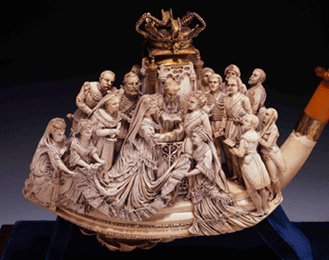
|
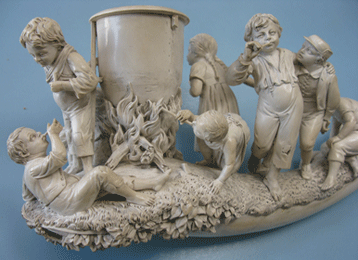
|
|
The motif of this 18-inch pipe depicts the wedding of Princess Louise, daughter of Queen Victoria, to the Marquis of Lorne at Windsor St. George chapel, March 21, 1871. Attributed to Joseph Krammer, Vienna, ca. 1871, it was once the property of the Dunhill Antique Pipe Museum collection. It sold at Christie's in London on May 23, 2006 for $50,000.
(Photo: Bruce Benjamin Collection.)
|
Carved by Carl Kiess of Vienna, Austria, this pipe belonged to Duke Franz Ferdinand who presented it to Emperor Franz Josef, Kaiser of Austria and King of Hungary. It ended up in the U.S. and depicts seven boys and one girl and is known as ÔÇťThe First SmokeÔÇŁ; 18 inches long. (From the Sarunas Peckus Collection.)
|
As early as 1851, the catalog of the Great Exhibition in London noted a number of awards to exhibitors of meerschaum pipes. Of one carver, Carl Astrath of Vienna, the catalog read: ÔÇťPrize Medal, for an assortment of most exquisite specimens of meerschaum pipe-bowls and cigar-tubes; the sculpturing of the figures displaying remarkable artistic skill, and the execution of leafage being bold and sharp.ÔÇŁ J. Strauss of Turin also received a prize medal for ÔÇťÔÇŽseveral elaborately-carved meerschaum pipe-bowls, the sculpturing of which is vey exquisite.ÔÇŁ
So many of these 19th century creations surpass ordinary creativity and craftsmanship and verge upon artistic genius to be compared with the larger-than-life creations in bronze, marble, alabaster and stone of Brancusi, Cellini, Maillol, Moore and Saint-Gaudens. This is one reason why the following appeared in a respected 19th century newspaper: ÔÇťA meerschaum pipe is one of the best things a man can have, and gives him more pleasure for the amount of money expended than anything else he can buy.ÔÇŁ The highest compliment ever paid to it is that it is as skillfully elaborated and as intricately fashioned as Japanese netsukes.
|
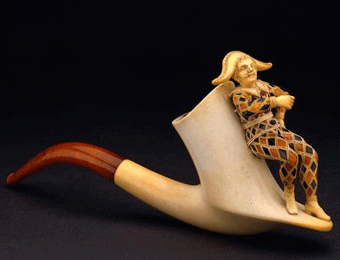
|
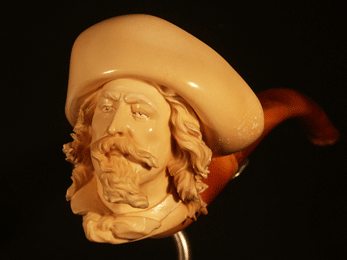
|
|
This meerschaum pipe, an exquisite rendition of a punch or harlequin, has a very rare feature, the polychrome coloration of his costume, a most unusual enhancement to a pipe. (From the Carlos Armero Collection.)
|
One of many renditions of ÔÇťBuffalo Bill" Cody as a pipe. Even without a fitted case that might have indicated who executed it, this pipe was made in AmericaÔÇöEuropean carvers rendered their own personalities, not America's. (Photo: Bruce Benjamin Collection.)
|
So what is meerschaum? It is neither a major industrial mineral nor a precious stone, but it still retains a record of a longÔÇöand continuingÔÇöassociation with art and the personal affairs of Man. It is not sea foam or the fossilized shells of tiny sea creatures that fell to the ocean floor over 50 million years ago, the stuff of myths posted on the Internet. (Meerschaum in German does mean sea foam, and there is no English-language equivalent word.) It is Mg4Si6O15(OH)2·6H2O, more commonly described as a soft, white, claylike material consisting of hydrated silicate of magnesium. The fascination with this substance is that the meerschaum mellows, mutates, and metamorphoses over time through a range of colors as it absorbs the pipeÔÇÖs byproducts of tobacco.
The mineral is found chiefly in Eski┼čehir, Turkey, the principal center of pipe carving and finished pipe export today, although there are small deposits in Tanganyika. Other than Turkey and Tanganyika, minor players in meerschaum pipe production are: Andreas Bauer (Vienna), London Meerschaum Limited, Darcy Gertz (Canada), Philippe Bargiel (France), and Arne Urup (Denmark). Although TurkeyÔÇÖs meerschaum pipes are popular among a certain contingent of smokers, these contemporary expressions are not, by any metric of carving excellence, in the same league with those crafted during the period 1850ÔÇô1925, meerschaumÔÇÖs ÔÇťGolden Age,ÔÇŁ when craftsmen on the Continent, in England and to a lesser extent, in the United States, plied this trade and produced thousands of eye-catching masterpieces fit for a puffing king ... or queen. The principal centers of meerschaum pipe manufacture were in the more cosmopolitan citiesÔÇöamong them, Berlin, London, Paris, Prague, Venice, and ViennaÔÇöin ateliers bustling with skilled, nameless artisans working alongside craftsmen of related guilds, the jewelers, metal smiths, wood turners and those who made pipe stems, mouthpieces, wind covers and assorted other pipe fittings.
|
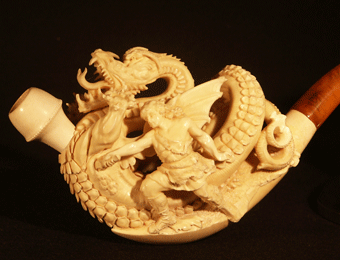
|
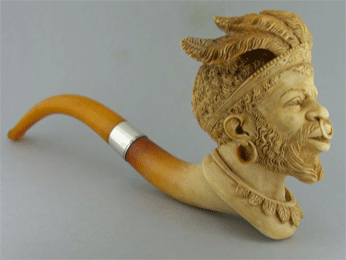
|
|
A rendition of the Norse tale of Siegfried and the dragon Fafnir in Richard Wagner's ÔÇťDer Ring des NibelungenÔÇŁ in the form of a cheroot holder.
(Photo: Bruce Benjamin Collection.)
|
This pipe is a spectacular Nubian male, most likely a tribal chief taking into account the headband, earrings, nose ring and decorative collar.
(Photo: Bruce Benjamin Collection.)
|
In brief, it started in a place called Pesth (Budapest) early in the 18th century; some claim 1720 as the precise year. The generally accepted account is that a Hungarian shoemaker Karl Kowates (Kovács, Károly) obtained a lump of raw meerschaum from a certain Hungarian diplomat-noble, Baron István Andrássy, who served the Ottoman court in Turkey, and the cobbler carved two relatively crude meerschaum pipes; a story so often repeated that it has become industry legend and collector folklore. From there, a cottage industry grew across Western Europe, where craftsmen learned to manipulate this chalky, milky-white, pliable mineral into pipes that competed with three popular materials used in pipe fabrication: clay (introduced in England in the late 1600s); porcelain (introduced near-simultaneously in France and Germany in the early 1700s); and briar (Erica arborea, the root of the heath tree, introduced in France in the mid-1850s). Wood pipes were available in Europe prior to 1850ÔÇöabout 30 different species were tested and triedÔÇöbut most fell into disfavor when the popularity of the briar surged. Other short-lived pipe mediums of the period were bisque, Parian ware (a cheap imitation of the white marble from the Greek island of Paros), jasperware, ivory, glass, amber and precious metals.
In those aforementioned 75 or so golden years, the meerschaum carverÔÇÖs imagination ran wild, and pipes, cheroot holders (a diminutive version of the pipe to hold a popular, torpedo-shaped cigar, rather than loose tobacco) and yet smaller, tapered cigarette holders of incomparable creativity and beauty were produced. Almost any motif one can name was expressed in meerschaum, the articulation of creative and dramatic imagery in one-of-a-kind, miniature architectural statements. The pipes usually mirrored famous works of art (paintings, sculpture), opera, fables, mythology, the Bible, busts of popular personages and important political/military leaders of the period, commemoration of historic events, and singular masterpieces for international expositions. In 1991, O. Henry Mace, author of CollectorÔÇÖs Guide to Victoriana (1991) opined: ÔÇťFamous faces, animals, erotica, and even landmarks have been reproduced on beautiful white meerschaum pipes.ÔÇŁ
So what did a prospective buyer encounter in the tobacco shop?
- An infinite variety of shapes and sizes with varying degrees of intricate bas- to high-relief-carved subject matter;
- A good percentage of pipes and holders exhibited whimsical, fanciful, bizarre and to the delight of some collectors, erotic and scatological motifs;
- An assortment of appliquéd embellishments and decoration, such as semi-precious and precious gems, and gold and silver repoussé accents;
- Mouthpieces of turned amber, ivory and exotic woods; and
- Custom-fitted carrying cases to protect the fragile meerschaum from damage and shield it from the sun or harsh showroom light that could dissipate the hand-rubbed beeswax finish.
In a word, name somethingÔÇöalmost anythingÔÇöand chances are that it was expressed in meerschaum. Many are one-of-a-kind pieces of history, and most evoke ingenious creativity and dramatic imagery. That's why collectingÔÇönot smokingÔÇöantique meerschaum pipes (albeit art that can be smoked) is as fascinating an avocation as the pursuit of Coca-Cola collectibles, stamps, coins, and Beanie Babies.
But, unlike the ability to identify these contemporary objects, no signature or trademark appeared on the pipes or inside their fitted cases, so it is anyoneÔÇÖs guess as to their provenance or date of manufacture. Dating and determining country of origin are difficult and not particularly rewarding.
|
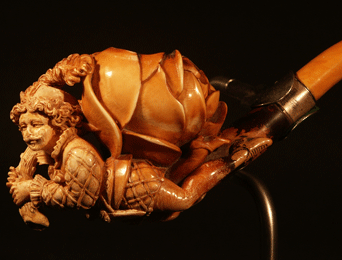
|
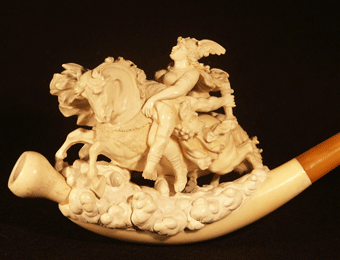
|
|
Pipe with an interesting motif, a gentleman in period dress, perhaps a medieval bard or a court jester, bearing a giant rose in full bloom; 6.5 inches in length.
(Photo: Bruce Benjamin Collection.)
|
A finely crafted cheroot holder with the high-relief-carved Brünnhilde (Brynhild), a shieldmaiden and a valkyrie in Norse mythology, in Richard Wagner's opera, "Der Ring des Nibelungen." (Photo: Bruce Benjamin Collection.)
|
Some facts to consider. Today, demand exceeds supply. Of the many thousands of meerschaum pipes and holders made a century or two ago, only a small fraction have survived in pristine condition. Whether purchased at a flea market or an antiques show, on eBay, or from a public auction, prices are wholly unpredictable. By current-market price points, especially on the Continent, one needs rather deep pockets to acquire these baubles. Many serious collectors remain in their closets using agents to do their bidding, so it is difficult to know the competition or their bidding strategy.
The price of an antique meerschaum can range anywhere from the low hundreds to thousands of dollars for something as splendid as a large-scale pipe depicting, in high relief, the god Prometheus surrounded by a handful of naiads made by someone in Vienna, Paris or Prague. No surprise, as W. A. Penn wrote in The Soverane Herbe: ÔÇťOur grandfathers highly valued their meerschaums. Collections of finely-coloured and carved pipes were made, as much as £500 being paid for a fine specimen.ÔÇŁ That was published in 1901!
Today, the prerequisites for amassing a respectable collection of meerschaum pipes or holders are persistence, diligence, commitment, networking, timing, lots of luck and extra income. The market is wholly unpredictable, and meerschaum pipes and cheroot holders are neither liquid nor near-liquid assets.
The current center of auction activity is Paris, at the Hôtel Drouot where, with regularity, there is a public auction of antique tobacco accessories. Occasionally, an American auction house deigns to traffic in antiquarian tobacco utensils.
Without documentationÔÇöold factory catalogs, artist renditions of pipe designs, or other archival materialÔÇöit is impossible to distinguish between a rare and a common motif, between a mass-produced motif and one that was custom-made for a client. This is an important criterion because to pay a top price, the pipe or holder ought to be an extraordinary objet dÔÇÖart that exhibits a magnificent tableau and exudes flawless execution, finesse and balance.
While legions of Americans strive for a smoke-free world, antique pipe collectors, the majority of whom are non-smokers, have embraced these utensils now long in disuse, and derive distinct pleasure from the appearance and tactility of a humble utensil that was, a century ago, a mere vessel for tobacco. Without their passion to collect, these objects would just be more detritus of the past, and the readers of Southeastern Antiquing Magazine would miss a sumptuous, visual feast of these antiquarian utensils of smoke. To see more of these bibelots, visit ÔÇťThe Tobacco Pipe Artistory,ÔÇŁ on Facebook.
-------------------------------
For the past 50 years, Ben Rapaport, known internationally as an avid antique pipe collector, bibliophile and a popular lecturer at pipe clubs, has been in journalistic wedlock with all things tobacco and smoke. His articles on pipe and tobacco history appear regularly in Pipes & Tobaccos Magazine. He was inducted as the U.S. Founding Member into the International Academy of the Pipe in 1985, into the Confrérie des Maîtres Pipiers de Saint-Claude, France, in 1989, and the recipient of the prestigious ÔÇťDoctor of PipesÔÇŁ achievement award from the Chicagoland Pipe Collectors Club in 2004. He is the author of A Tobacco Source Book (1972); A Complete Guide to Collecting Antique Pipes (1979); The Global Guide to Tobacco Literature (1989); Museum of Tobacco Art and History Guide Book. (1996); Collecting Antique Meerschaums: Miniature to Majestic Sculpture, 1850-1925 (1999); and The Arts of An Addiction: Qing Dynasty Opium Pipes and Accessories (2005). His seventh book, The European Porcelain Tobacco Pipe is scheduled for release in the fall of 2014.
All photos not credited are courtesy of the Bruce Benjamin Collection.
|